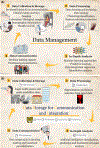Clinical decision support systems in orthodontics: A narrative review of data science approaches
- PMID: 33973362
- PMCID: PMC8988880
- DOI: 10.1111/ocr.12492
Clinical decision support systems in orthodontics: A narrative review of data science approaches
Abstract
Advancements in technology and data collection generated immense amounts of information from various sources such as health records, clinical examination, imaging, medical devices, as well as experimental and biological data. Proper management and analysis of these data via high-end computing solutions, artificial intelligence and machine learning approaches can assist in extracting meaningful information that enhances population health and well-being. Furthermore, the extracted knowledge can provide new avenues for modern healthcare delivery via clinical decision support systems. This manuscript presents a narrative review of data science approaches for clinical decision support systems in orthodontics. We describe the fundamental components of data science approaches including (a) Data collection, storage and management; (b) Data processing; (c) In-depth data analysis; and (d) Data communication. Then, we introduce a web-based data management platform, the Data Storage for Computation and Integration, for temporomandibular joint and dental clinical decision support systems.
Keywords: artificial intelligence; decision support systems; machine learning; orthodontics.
© 2021 John Wiley & Sons A/S. Published by John Wiley & Sons Ltd.
Conflict of interest statement
CONFLICT OF INTEREST
The authors declare no potential conflicts of interest with respect to the authorship and/or publication of this article.
Figures




References
-
- Dash S, Shakyawar S, Sharma M, Kaushik S. Big data in healthcare: management, analysis and future prospects. J Big Data. 2019;6(1):1–25. 10.1186/s40537-019-0217-0 - DOI
-
- Frank M, Drikakis D, Charissis V. Machine-learning methods for computational science and engineering. Computation. 2020;8(1):15. 10.3390/computation8010015 - DOI
Publication types
MeSH terms
Grants and funding
LinkOut - more resources
Full Text Sources
Other Literature Sources
Medical

